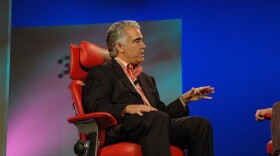Cutting Medicaid has been a big component of New York Governor Andrew Cuomo's plans to keep taxes in the state flat (something businesses love). Casey Seiler at the Times Union has the details on the findings of the state's Medicaid Redesign Team, which filed its recommendations to that effect a week early:
The major elements of the package include a 4 percent cap on the state's share of Medicaid, which would be pegged at slightly more than $15 billion. The gross cost of New York's Medicaid program, including federal funds, would be almost $53 billion. To enforce the cap, the state Department of Health and the Budget Division would be charged with monitoring month-to-month spending, and would be empowered to impose "utilization controls" and rate reductions if those agencies determined it was about to be exceeded. The plan would also initiate a rapid expansion of the use of managed care programs: Within three years, almost all Medicaid recipients would be entered into a program in which all major aspects of their care would be centrally monitored. Critics of current Medicaid practices note that one of the main cost drivers is the hodgepodge nature of much of its spending, especially on the state's most vulnerable.
The early results help the governor move along the state's budget process, which until now has had a big question mark where savings for Medicaid should be:
Cuomo said the conclusion of this aspect of the team's work fills in what his critics said was a nearly $3 billion blank spot in his budget proposal, which he wants to see passed by the start of the new fiscal year on April 1. "Well, we just filled in the blank, OK?," Cuomo said. "The questions have been answered. Now we need the Legislature to fill in the blank and to do their job, and to get a budget passed on time."
Kodak
Kodak has forged a partnership with Konica Minolta to co-market each other's products globally, reports Matt Daneman at the Democrat and Chronicle:
Under the Kodak-Konica agreement, Konica Minolta will start selling Kodak's Nexpress color presses in addition to Digimaster. Kodak, meanwhile, will sell the Konica Minolta bizhub Press C6000, C7000 and C8000 in the U.S., United Kingdom, Germany and France, and the Konica Minolta bizhub Pro 1200/1200P monochrome digital presses in the U.S. Kodak also will offer all the equipment, controllers and accessories associated with the Konica Minolta portfolio. The products of both companies will maintain the manufacturer's brand.
In other good news for Kodak, the FDA has given a Kodak laser technology a key approval to help move better projection technology to movie theaters. Mike Dickinson at the Rochester Business Journal reports:
Kodak explained that typically digital projection systems that use high power lasers fall under the definition of a “demonstration laser” and must follow existing regulations for conventional laser projectors, such as those used in laser light show displays. Kodak has been working with laser safety consultants and the FDA to address potential safety issues. The Kodak technology promises to bring improved image quality to theater screens, including brighter 3-D viewing, and to reduce costs of digital projection in cinemas through long-life lasers, lower-cost optics and more efficient energy usage, Kodak officials said. The company introduced its laser technology in September 2010. Kodak is in discussions to license the technology, and aims to have it in the marketplace within two years, [Kodak COO Les] Moore said.
GM
Tom Krisher with AP reports that GM has had its first profitable year since 2004, picking up $4.7 billion:
GM executives predicted Thursday that the automaker would build on last year’s earnings as sales continue to rise, especially in North America. With a good performance by GM this year, the U. S. government could recover more of its $49.5 billion bailout, nearly half of which has been repaid. And GM could even retake the title of world’s largest automaker, held by Toyota since 2008. GM sold 8.39 million cars and trucks worldwide in 2010, coming within 30,000 vehicles of unseating Toyota, which has been wounded by a string of safety recalls, including another big one on Thursday. That 30,000-vehicle difference works out to a little more than a day’s worth of sales for GM.
But not so fast - rising oil prices following turmoil in North Africa and the Middle East could threaten those gains, according to Krisher.
Jacob Goldstein at NPR's Planet Money breaks out the three big bullet points behind the profits:
- GM cut jobs
- GM sold a ton of cars
- GM has pulled it together
Earnings
- Stantec, a Canadian firm with offices in Endicott and Rochester, picked up 55 cents a share in the fourth quarter (My-Ly Nguyen, Press & Sun-Bulletin).
- VirtualScopics, based in the Rochester suburb of Pittsford, grabbed a 20 percent gain in revenue (Democrat and Chronicle).
Want more money news from the Innovation Trail? Subscribe to the feed.






